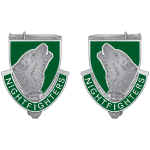
Back 104th Infantry Division (Vereinigte Staaten) German لشکر ۱۰۴ پیاده (ایالات متحده آمریکا) Persian 104e division d'infanterie (États-Unis) French הדיוויזיה ה-104 (ארצות הברית) HE 104th Infantry Division Italian 104. pehotna divizija (ZDA) Slovenian
| 104th Training Division | |
|---|---|
 104th Division insignia | |
| Active | 24 June 1921 – 20 December 1945 1 December 1946 – present |
| Country | |
| Allegiance | |
| Branch | Army Reserve |
| Type | Training Division |
| Role | Training |
| Size | Division |
| Garrison/HQ | Fort Lewis, Washington |
| Nickname(s) | "Timberwolf Division"[1] "Nightfighters"[2] |
| Motto(s) | "Nothing in Hell can stop the Timberwolves"[1] "We Succeed"[3][4] |
| Engagements | World War II |
| Commanders | |
| Commanding officer | Colonel Kristina Green |
| Command Sergeant Major | Command Sergeant Major Neil Pierce |
| Notable commanders | Gilbert R. Cook (1942–1943) Terry de la Mesa Allen Sr. (1944–1945) |
| Insignia | |
| Distinctive Unit Insignia |  |
The 104th Infantry Division was an infantry division of the United States Army. Today, it is known as the 104th Training Division (Leader Training) and based at Fort Lewis, Washington, as a training unit of the United States Army Reserve.
Activated in 1921 and deployed during World War II, the division saw almost 200 days of fighting in northwestern Europe as it fought through France, Netherlands, Belgium, and western Germany, fighting back several fierce German counterattacks as it advanced through the theater throughout late 1944 and 1945. This was the only combat duty that the 104th Infantry Division has served during its history. At the end of the fighting on 7 May 1945 (V-E Day), this division was in central Germany opposite the troops of its allies from the Soviet Army.
After World War II, this division was reorganized primarily as a training division for Reserve forces. After several decades, the division then expanded its role to conducting entry-level training for soldiers of all branches of the Army in the northwestern United States. Its role and size have expanded over that time due to the consolidation of other training commands, and the division subsequently took charge of a number of brigades specializing in various entry-level training for soldiers of all types.
- ^ a b Order of Battle, p. 410.
- ^ Cite error: The named reference
TIOHwas invoked but never defined (see the help page). - ^ "Army Mottos". The Institute of Heraldry. Archived from the original on 14 July 2012. Retrieved 5 August 2012.
- ^ Stein, Barry Jason; Capelotti, Peter Joseph (1993). U.S. Army Heraldic Crests: A Complete Illustrated History of Authorized Distinctive Unit Insignia. Univ of South Carolina Press. p. 107. ISBN 978-0-87249-963-8. Retrieved 5 August 2012.
© MMXXIII Rich X Search. We shall prevail. All rights reserved. Rich X Search